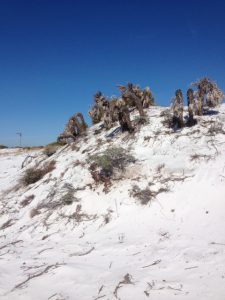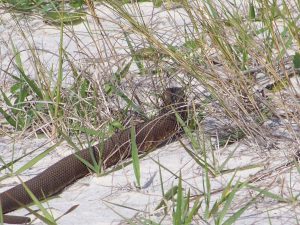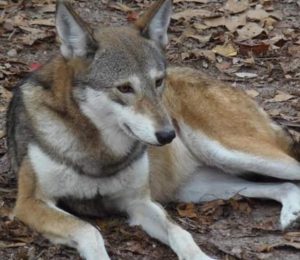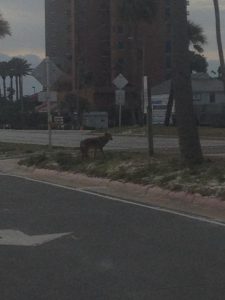Those of us who enjoy wildlife viewing do not see much this time of year. The days are shorter and colder. Most creatures have left or are hiding from the winter air. We grew up learning about hibernation and winter life for animals. But why do they do this? And are all of them doing so?

Photo: Rick O’Connor
It is all about temperature. Our bodies have an internal temperature that must remain within a specific range for us to survive. Some creatures can survive at much higher temperatures than others, such as the desert pupfish. This fish lives in pools out west where water temperatures average 93°F. Others can live in very low temps, such as the Antarctic icefish – who live in water in the 28°F range. But most live with body temperatures in the 85-95°F, and most prefer to keep their body temperatures near the upper limit of their tolerance range.
How do they do this when it is cold outside?
Well, the can absorb heat externally – from the sun, the ground, being in contact with warm solid objects, and even from the air. For some creatures, this is their primary method of absorbing heat. We call them “ectotherms” – or “cold blooded”. These “cold bloods” have low metabolism, so they do not generate enough internal heat to help. Many also have an outer covering (scales) that is not a good insulator, so they cannot hold on to the heat they do produce. Most “cold bloods” are no where to be found this time of year. It is far too cold outside. Their food (the source for internal metabolic heat) is nowhere to be found either. Some of the “cold bloods” will find a burrow, or some location out of the elements and go into torpor (sleep). Torpor will allow them to slow their metabolism, which is going to happen anyway, to where their heart and respiration rates drop dramatically. This reduces the chance of losing more heat during breathing (which happens) and the low metabolism allows them to survive on stored energy until spring.

Photo: Rick O’Connor
There are different levels of torpor. Some “cold bloods” are in DEEP torpor (true hibernation) and are basically unresponsive to external stimuli. Others are not so “deep” and may move around during winter. Snakes may emerge on warm sunny days in January to bask near the burrow entrance and regain some heat. Other “cold bloods” may just pack up and move – migrate – where it is warmer. This happens more with fish than reptiles and amphibians.
Then there are the endotherms, or “warm bloods”. These animals can maintain a relatively high body temperature this time of year and remain active – even seek out and hunt hibernating creatures. How do they do this?
First, they have a higher metabolism rate than “cold bloods”, and thus generate more internal heat. There is a cost for this though – 80-90% of the food they consume goes to maintaining their body temperature (and I say they… that would be WE…). This means “warm bloods” must eat more often and this can be problematic in winter when your favorite prey is in hibernation or has migrated.
In addition to producing more heat, their body covering (fur or feathers) helps insulate them so they do not lose the heat they have produced. “Fluffing” the fur or feathers helps some as well. There is a biological principal known as Bergmann’s Rule that states, “larger animals can maintain their body temperature better than smaller ones”. This has to do with surface area : volume ratios, and an article for another day, but let’s just say bigger animals can maintain a warmer body and remain more active. That said, smaller mammals (beach mice) may still need to hibernate or enter some form of torpor to survive this time of year.

Photo: Molly O’Connor
One mammal that some folks on the beach still encounter this time of year is the coyote. One of the larger mammals in the beach ecosystem, and a top predator, coyotes are still active in winter. Actually, it is breeding time for them. The females usually find a denning spot as it becomes cold and gestation will last about 60 days; so, the pups will be here soon. The average number of pups / female is six; a pretty big family to feed honestly. At that point, in a few weeks, she will be seeking food to produce milk to nourish her pups – who will be sexually mature and ready to reproduce by Thanksgiving.
Many who have encountered, and I spoke with one beach resident who recently saw one, are still nervous around them and not sure what to do. Despite the group calls (howls) they are famous for, they are not as social as wolves and can be seen alone. They have a natural fear of humans and try to avoid us. They are fantastic consumers of rodents (their favorite prey) and this sometimes brings them close to homes and businesses. They are more crepuscular (dawn and dusk) and nocturnal, so encounters are not common, but they happen. Usually when a coyote spots us, they freeze and then slide off into the night. This is good, and normal. Animals that stand their ground or approach humans can be a problem. They usually only do this when (a) they are sick and not acting normal, or (b) they have been fed by humans. This is not always intentional. Sometimes folks place their cat food outside for their cats and turn in for the night. If the coyotes find this, they will be back. In other cases, it has been intentional, and we strongly recommend you do not do this. In one study they found in Chicago, where coyotes do live but encounters are rare, their stomach content only had about 2% human food. Compare this with coyotes in southern California, where human food content is around 25% and negative human encounters are more common.

Photo: Lois
There is also concern about coyotes taking small pets. This happens. All predators are seeking prey that is easy to kill – where they can feed and not expend a lot of energy to make the kill. Small pets are easy to kill, larger than rodents, and carry more energy for them. It is recommended that you bring your small pets indoors during the evening.
The County Extension office provides a monthly program called SCIENCE HOUR each month. Next month (February 7) the topic will be coyotes and pet safety. The presentation will be given by Catherine Kennedy from FWC. We encourage all who have concerns about coyotes to come hear the talk and ask questions. Science Hour is held at the Escambia County Central Office Complex in Pensacola. 3346 West Park Place. We begin at 6:00 PM and it is free.
Though we see less wildlife this time of year, it is great time to walk the beaches. Get out and enjoy.
 0
0
